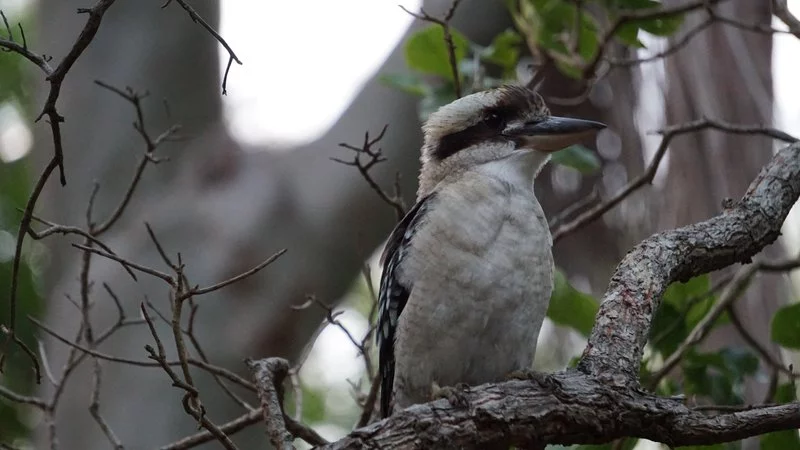The kookaburras are a group of birds in the kingfisher family. They are the largest of all the kingfishers and there are currently four species of kookaburra, and all are native to either Australia and/or New Guinea. Here in Australia we can see two of those four species, the blue winged kookaburra and the famous laughing kookaburra. The call of the laughing kookaburra can be recognised by most people inside or outside of Australia, it has been used many times as a sound effect in films, tv shows and even theme park rides.
The laughing kookaburra is native to eastern Australia, although it can be found in the south west of Western Australia and Tasmania due to it being introduced there. It is the largest of the four species growing to between 40-47 centimetres in length and can weigh around 352 grams on average. These birds have white/cream coloured plumage over most of their body apart from the wings, back and tail. The wings and back are brown with blue spots over the top of the wings and the tail is a reddish brown with horizontal bars of darker brown and a blue patch at the base. They also have a brown strip over each eye, this helps to identify them from their smaller cousin the blue winged kookaburra. The male and females of these species both look very similar with females being slightly larger.

As the name suggests the laughing kookaburra laughs. This is actually a call which they use to attract mates and establish and maintain territories between groups. This species takes its territory quite seriously as they prefer to remain in a particular area rather than moving around. If a rival group is nearby when a kookaburras call starts and replies, all members of the family groups will join in the call and the bush will be filled with a maniacal laughing sound which is quite an experience for those around to hear it. These family songs can be quite complex and require a bit of coordination, and young birds have to be taught the call by their parents. The laughing kookaburra is monogamous so the family groups are made up of the main breeding pair and their adult offspring from previous years which act as helper birds, these family groups are very fittingly known as riots.
The blue winged kookaburra can be found in New Guinea and northern Australia. It is slightly smaller than the laughing kookaburra reaching 42 centimetres in length and weighing up to 330 grams. Unlike the laughing kookaburra, these guys are sexually dimorphic, which means that males and females look different. The plumage of the males of this species is mostly white/cream with brown streaks and brown on the wings with distinct blue running down the outer edge of the wing. The tail of the males is also blue. The colouring of the female is quite similar except the tail is reddish brown with darker bars.
Like the laughing kookaburra this species also has a loud call although it is not described as a laugh, it is closer to a maniacal tackling or barking. They also live in family groups with specific territories. These groups can have up to 12 individuals and consist of the breeding pair and other helper birds which are offspring which have stayed in the parent territory to help defend it and also to help raise new chicks and participate in group hunting.
Like all birds in the kingfisher family kookaburras are carnivorous however they rarely hunt or spend much time around water. Instead they prefer to feed on a variety of different animals such as insects, frogs, lizards, mice and other small mammals and even snakes. Kookaburras have adopted the sit and wait method for hunting, they will find a good vantage point, usually a branch or wire, and wait patiently for prey to pass under before they swoop down and pick them up. They kill their prey either by crushing in their strong beaks or smashing it against the ground or tree if their prey is large. They have even been known to swoop in on the unsuspecting BBQ and steal a sausage right of the hot plate.
Due to humans encroaching on their natural habitat kookaburras are now not only found in the Australian bush but also in close proximity to humans, around towns and cities. This makes them quit an easy target for bird watchers. Here in the Whitsundays kookaburras can be seen on both the main land and out around the islands. The best time to see them is at dawn and dusk, which is also when you are most likely to hear their famous laughing call, just look up to the eucalyptus and large trees.



